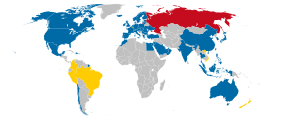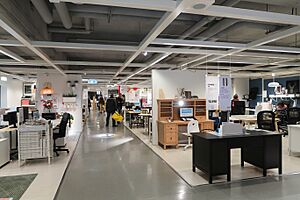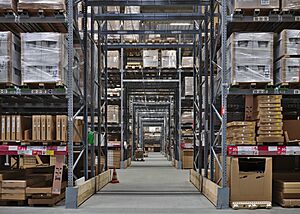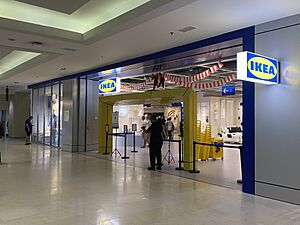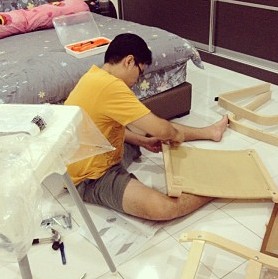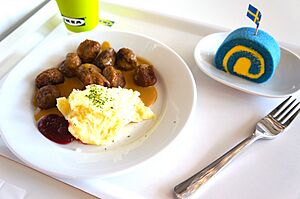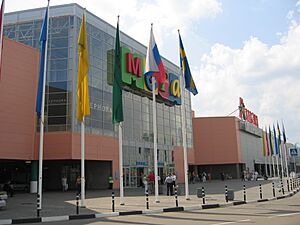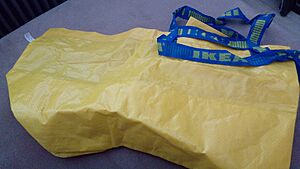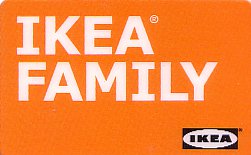IKEA facts for kids
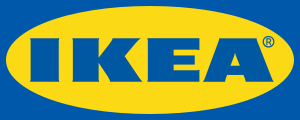 |
|
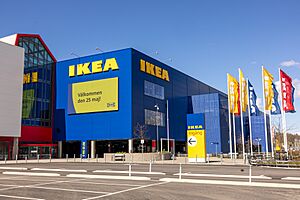
IKEA store in Kållered, Gothenburg, Sweden
|
|
|
Trade name
|
IKEA |
|---|---|
| Private | |
| Industry | Retail |
| Founded | 28 July 1943 in Sweden |
| Founder | Ingvar Kamprad |
| Headquarters | Delft, Netherlands (Inter IKEA Systems B.V.) Leiden, Netherlands (INGKA Holding B.V.) |
|
Number of locations
|
483 (2025) |
|
Area served
|
Worldwide |
|
Key people
|
|
| Products | |
| Revenue | |
| Parent | Inter IKEA Group |
IKEA is a big company from Sweden that designs and sells furniture you put together yourself. They also sell things for your home and yummy food.
IKEA was started in 1943 by a person named Ingvar Kamprad. Since 2008, it has been the world's biggest furniture seller. The name IKEA comes from Ingvar Kamprad's initials, plus the names of his family farm (Elmtaryd) and his hometown village (Agunnaryd) in Sweden.
The company is famous for its modern furniture designs and simple ways to decorate your home. Their stores are like big showrooms where you can walk through decorated rooms and see how the furniture looks. IKEA also tries to keep prices low by making furniture that you can easily put together at home.
IKEA is run by different groups of companies, mainly the Inter IKEA Group and Ingka Group. The IKEA brand itself is managed by Inter IKEA Systems B.V., which is based in the Netherlands. As of April 2025, there are 483 IKEA stores in 63 countries. In 2024, IKEA sold €45.1 billion worth of goods. Most IKEA stores are run by Ingka Group, which pays a fee to Inter IKEA Systems for using the brand. The IKEA website has about 12,000 products and had over 4.6 billion visitors in 2024.
Contents
IKEA's Journey: A Look at Its History
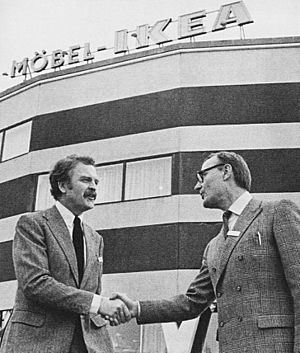
In 1943, when he was just 17, Ingvar Kamprad started IKEA as a business that sold things by mail. Five years later, he began selling furniture. The very first IKEA store opened in 1958 in Älmhult, Sweden. It was first called Möbel-IKÉA, which means "furniture-IKEA" in Swedish.
The first IKEA stores outside Sweden opened in Norway in 1963 and Denmark in 1969. In the 1970s, IKEA stores started appearing in other parts of Europe, like Switzerland (1973) and West Germany (1974). They also opened in Japan (1974), Australia, Hong Kong (1975), and Canada (1976).
IKEA kept growing in the 1980s, opening stores in countries like France (1981), the United States (1985), and the United Kingdom (1987). Today, Germany and the United States have the most IKEA stores, with 55 each.
IKEA opened its first store in India in 2018, in Hyderabad. Now, there are also stores in Bengaluru and Mumbai. In November 2021, the world's largest IKEA store opened in the Philippines, in Pasay City, Manila. It is huge, measuring 65,000 square meters!
In March 2022, IKEA announced it was closing all 17 of its stores in Russia because of the conflict in Ukraine. Later, IKEA said it would sell its factories and reduce its staff in Russia.
IKEA was also affected by the COVID-19 pandemic. Because of lockdowns, the company stopped printing its yearly catalogue after 70 years. Product prices also went up in 2022 due to higher costs.
In August 2022, IKEA opened its first store in Chile, which was the first in South America. Another store opened in Colombia in September 2023, in Bogotá.
Where IKEA Stores First Opened
Here's when IKEA first opened stores in different countries:
- 1958,
 Sweden
Sweden - 1963,
 Norway
Norway - 1969,
 Denmark
Denmark - 1973,
 Switzerland
Switzerland - 1974,
 Germany,
Germany,  Japan
Japan - 1975,
 Australia,
Australia,  Hong Kong
Hong Kong - 1976,
 Canada
Canada - 1977,
 Austria
Austria - 1978,
 Netherlands,
Netherlands,  Singapore,
Singapore,  Spain
Spain - 1981,
 France,
France,  Iceland
Iceland - 1983,
 Saudi Arabia
Saudi Arabia - 1984,
 Belgium,
Belgium,  Kuwait
Kuwait - 1985,
 United States
United States - 1987,
 United Kingdom
United Kingdom - 1989,
 Italy
Italy - 1990,
 Hungary,
Hungary,  Poland
Poland - 1991,
 Czech Republic,
Czech Republic,  Serbia,
Serbia,  United Arab Emirates
United Arab Emirates - 1992,
 Slovakia
Slovakia - 1994,
 Taiwan
Taiwan - 1996,
 Finland,
Finland,  Malaysia
Malaysia - 1998,
 China
China - 2000,
 Russia
Russia - 2001,
 Greece,
Greece,  Israel
Israel - 2004,
 Portugal
Portugal - 2005,
 Turkey
Turkey - 2007,
 Cyprus,
Cyprus,  Romania
Romania - 2008,
 Ireland
Ireland - 2010,
 Dominican Republic
Dominican Republic - 2011,
 Bulgaria,
Bulgaria,  Thailand
Thailand - 2012,
 Macau
Macau - 2013,
 Lithuania,
Lithuania,  Puerto Rico,
Puerto Rico,  Egypt,
Egypt,  Qatar
Qatar - 2014,
 Croatia,
Croatia,  Indonesia,
Indonesia,  Jordan,
Jordan,  South Korea
South Korea - 2016,
 Morocco
Morocco - 2017,
 Serbia
Serbia - 2018,
 Bahrain,
Bahrain,  India,
India,  Latvia
Latvia - 2019,
 Estonia
Estonia - 2020,
 Ukraine
Ukraine - 2021,
 Mexico,
Mexico,  Philippines,
Philippines,  Slovenia
Slovenia - 2022,
 Chile,
Chile,  Oman
Oman - 2023,
 Colombia
Colombia
Exploring an IKEA Store: Layout and Design
IKEA stores are usually blue buildings with yellow parts, like the colors of the Swedish flag. They are often designed so you walk in one direction, like a maze. This is to make sure you see everything in the store. There are also shortcuts if you want to go to a specific section.
You usually start in the furniture showrooms. These areas look like real rooms in a house, with sofas, beds, and kitchens. You can see how the furniture looks and try it out. After the showroom, you get a shopping cart and go to the "Market Hall" for smaller items.
Finally, you reach the self-service furniture warehouse. Here, you pick up the flat-packed furniture you chose earlier. Sometimes, you might pick up items from a separate warehouse nearby. Then, you pay for your items at the cash register.
Most IKEA stores have the showroom upstairs and the marketplace and warehouse downstairs. Some stores are all on one level, especially where land is cheaper.
Most IKEA stores also have an "as-is" or "bargain corner" area. This is where returned, damaged, or display products are sold at a lower price.
Different Kinds of IKEA Stores
Most IKEA stores are outside city centers because land is cheaper there. However, IKEA has tried different, smaller store ideas.
New Full-Size Store Designs
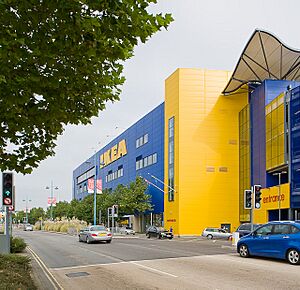
IKEA opened new types of full-size stores in city centers, like in Manchester, England, in 2006. Another one in Coventry opened in 2007 but closed in 2020. These stores had different layouts from the usual IKEA stores.
IKEA in Japan: Learning and Adapting
IKEA had a tough start in Japan. They left in 1986 but came back in 2006 with a new plan. They learned that Japanese customers didn't usually put furniture together themselves. Also, many lived in small apartments and couldn't easily take large flat-packs home.
So, before returning, IKEA studied how Japanese people lived. They made sure their room displays looked like real Japanese apartments. For example, they created a room for "a typical Japanese teenage boy who likes baseball and computer games." This helped them succeed.
City Center Stores Around the World
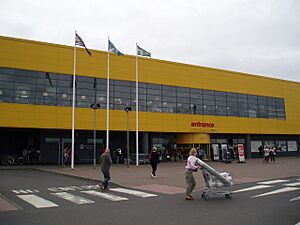
In China, IKEA stores are often closer to public transportation because many customers don't have cars. Some "mini-IKEA" stores are even in downtown shopping centers. IKEA has also used "pop-up" stores on social media to reach new customers.
IKEA is opening a new store in central London on Oxford Street in May 2025.
Smaller IKEA Stores
In places like Hong Kong, where space is expensive, IKEA has opened smaller stores in multi-story buildings. These stores are still big for Hong Kong, but smaller than typical IKEA stores. IKEA also changes product sizes to fit different cultures.
In 2020, IKEA opened one of its smallest stores in Abu Dhabi, United Arab Emirates, which was only 2,137 square meters. They also opened small stores in Kuwait and Harajuku, Tokyo. The Harajuku store even has IKEA's first "konbini" (convenience store) concept. In 2021, IKEA opened a small store in Singapore that didn't have the usual "Market Hall" warehouse.
IKEA's Products and Services
Furniture and Home Goods
Most of IKEA's furniture comes in flat packs that you put together yourself. IKEA says this helps save money and packaging because they don't ship empty space. It's also easier for customers to carry flat-packs home.
IKEA tries to be sustainable. They call their approach "democratic design," meaning they make products that are good for many people and the environment. They use materials like "particle board" to keep costs down and use fewer resources.
Some famous IKEA furniture items include the Poäng armchair, the Billy bookcase, and the Klippan sofa. Millions of these have been sold since the 1970s and 1980s.
IKEA and LEGO also worked together to create simple storage solutions for kids and adults.
How IKEA Names Its Products
IKEA products have one-word (sometimes two-word) names, mostly from the Swedish language. The founder, Ingvar Kamprad, had dyslexia, so he found it easier to remember products by names instead of long codes.
Products are usually named after places in Scandinavian countries. For example, sofas and coffee tables are named after places in Sweden. Textiles are named after places in Denmark, and beds after places in Norway. Lamps get names from seas and lakes, while outdoor furniture is named after islands.
Sometimes, Swedish names can sound funny or even a bit rude in other languages. For example, a computer desk was once called jerker, and a plant spray was called fukta (which means "moisten"). IKEA has sometimes changed names because of this.
In 2021, VisitSweden.com even made a fun campaign called "Discover the Originals." It invited tourists to visit the real places that share names with IKEA products, like the lake Bolmen (which is also a toilet brush).
Design Help
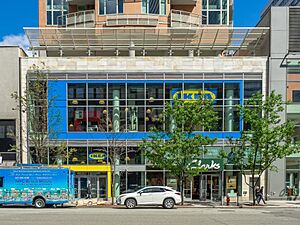
In March 2021, IKEA launched an app called IKEA Studio with Apple Inc.. This app lets customers design rooms with IKEA furniture using augmented reality on their iPhones. You can see how furniture would look in your own room!
Smart Home Products
In 2016, IKEA started selling smart home products. Their TRÅDFRI smart lighting kit was one of the first. IKEA also works with Philips Hue for smart lighting. They even have furniture with wireless charging built in.
IKEA also teamed up with Sonos to make smart speakers that look like furniture. These speakers, called SYMFONISK, can be lamps or bookshelf speakers. They work with the Sonos app and IKEA's Home Smart app.
Houses and Apartments
IKEA has also started selling flat-pack houses and apartments called BoKlok. They do this to help people buy their first home at a lower price. This project started in Sweden in 1996 with a company called Skanska.
Solar Panels for Homes
In 2013, IKEA started selling solar panel packages for houses in the UK. These "residential kits" help homes use clean energy. By 2014, they also sold them in the Netherlands and Switzerland.
Renting Furniture
In 2019, IKEA began testing a new idea: renting furniture to customers. This was partly because some people saw inexpensive IKEA products as "disposable." By renting, furniture can be used more times before being recycled, which is better for the environment.
Restaurants and Food Markets

The first IKEA store in 1958 had a small cafe, which became a full restaurant in 1960. IKEA restaurants are famous for their Swedish meatballs, lingonberry jam, and other Swedish foods.
The menu changes a bit depending on the country. For example, you might find shawarma in Saudi Arabia or poutine in Canada. In Indonesia, the meatballs are made to be halal. In Israel, the stores sell kosher food.
IKEA restaurants often open before the main store and serve breakfast. Food makes up about 5% of IKEA's total sales. IKEA also sells plant-based meatballs made from potatoes, apples, and peas.
Småland: A Fun Place for Kids
Every IKEA store has a special play area for children called Småland. This name means "small lands" in Swedish, and it's also the name of the region in Sweden where IKEA's founder was born. Parents can drop off their children at the playground and pick them up later. In some stores, parents get a pager so staff can call them if needed. The biggest Småland play area is at the IKEA store in Navi Mumbai, India.
IKEA Preowned: Selling Used Items
In August 2024, IKEA started testing an online marketplace called IKEA Preowned. This is a place where customers can buy and sell used IKEA items. It was tested in Oslo, Norway, and Madrid, Spain.
Other IKEA Ventures
Until September 2023, IKEA owned and ran the MEGA Family Shopping Centre chain in Russia. These shopping centers were later sold to a Russian bank.
IKEA also had a mobile phone network in the UK called IKEA Family Mobile, but it stopped operating in 2015.
IKEA has worked with TCL to make TVs and entertainment systems. They also planned to open economy hotels in Europe, but these hotels would not use the IKEA name or furniture. As of April 2018, IKEA only owned one hotel, the IKEA Hotell in Älmhult, Sweden.
From 2016 to 2018, IKEA sold a bicycle called the Sladda. In 2017, IKEA bought the company TaskRabbit, which helps people find others to do tasks for them.
In 2020, IKEA partnered with Pizza Hut Hong Kong. They launched a side table that looked like a pizza saver, and the instructions suggested ordering a Swedish meatball pizza from Pizza Hut!
In July 2020, IKEA opened a special concept store in Tokyo, Japan, where they launched their first ever clothing line.
How IKEA is Organized
IKEA is made up of different companies. The main parts are INGKA Holding B.V. and Inter IKEA Systems B.V.
INGKA Holding B.V. owns the Ingka Group, which runs most of the IKEA stores and handles customer services. The IKEA brand itself is owned and managed by Inter IKEA Systems B.V., which is also in charge of designing and making IKEA products.
Inter IKEA Systems is owned by the Interogo Foundation, which is based in Liechtenstein. In 2016, the INGKA Holding sold its design and manufacturing parts to Inter IKEA Holding.
In 2013, Ingvar Kamprad stepped down from the board of Inter IKEA Holding. His youngest son, Mathias Kamprad, took over as chairman. Mathias and his two older brothers help guide the company's overall plans.
IKEA's Finances
In 2009, the IKEA Group made a net profit of €2.538 billion from sales of €21.846 billion. Because INGKA Holding is owned by a non-profit foundation, much of this profit is not taxed.
The Ingka Group pays a fee of 3% of its sales to Inter IKEA Systems for using the IKEA brand.
Making and Delivering IKEA Products
Even though IKEA started in Sweden, its products are made in many different countries to keep costs low. For most products, you put them together yourself at home.
Swedwood, a company owned by IKEA, makes all of IKEA's wood products. Their largest factory is in Poland. IKEA uses "particle board" instead of solid hardwood for many items.
IKEA uses smart warehouse systems with robots to make sure products get to stores and customers efficiently. In 2020, IKEA was known for having one of the most automated warehouse systems in the world.
IKEA's Environmental Efforts
IKEA has worked hard to be more environmentally friendly. In 1992, they created an Environmental Action Plan. Here are some of the things they do:
- They stopped using certain chemicals like polyvinylchloride (PVC) in many products and packaging.
- They try to use very little formaldehyde in their products.
- They made a chair from 100% recycled plastic.
- They use wood from forests that are managed responsibly, meaning new trees are planted.
- They use only recyclable materials for their flat packaging.
- In Denmark, they offer rental bicycles with trailers for customers.
IKEA also has a code of conduct for its suppliers, making sure they follow rules about social, safety, and environmental issues.
Product Journey and Sustainability
To make IKEA more sustainable, they think about a product's entire journey. Products are designed to be flat-packed for easier shipping and to be easy to take apart and recycle. IKEA works with environmentally friendly forests and cotton farms that avoid too many chemicals and water.
IKEA stores recycle waste and many use renewable energy. Employees are trained in environmental responsibility. IKEA also tries to locate stores near public transportation. The coffee and chocolate sold at IKEA stores are certified to be sustainably sourced.
At the end of a product's life, IKEA encourages recycling. Many stores have bins for light bulbs and batteries.
Energy Choices
In 2008, IKEA started IKEA GreenTech, a fund to invest in green technologies like solar cells and energy-saving products.
IKEA wants to use only renewable energy for its operations. In 2011, they announced plans to build a wind farm in Sweden. As of June 2012, 17 IKEA stores in the United States were powered by solar panels. IKEA also owns wind farms in Texas and Finland.
In 2019, IKEA announced they would invest $2.8 billion in renewable energy. Their goal is to make their entire supply chain "climate positive" by 2030.
Where IKEA Gets Its Wood
IKEA uses a lot of wood, about 1% of all wood used for commercial products worldwide. IKEA says that 99.5% of the wood they use is either recycled or certified by the Forest Stewardship Council (FSC). This means it comes from forests that are managed responsibly.
IKEA owns about 136,000 acres of forest in the US and about 450,000 acres in Europe. They are the largest private landowner in Romania since 2015.
Smart Packaging and Bags
Since March 2013, IKEA has stopped giving out plastic bags. Instead, they sell reusable bags. Their restaurants also use reusable plates and cutlery. Some IKEA bathrooms have special toilets that save water. IKEA stores also have recycling bins for light bulbs and batteries.
In 2001, IKEA was one of the first companies to use its own trains to transport goods across Europe.
Electric Vehicles
IKEA has added electric car charging points for customers at all its UK locations. This helps people who drive electric cars.
Since 2016, IKEA has only sold energy-efficient LED lightbulbs, lamps, and light fixtures. LED bulbs use much less power than old-fashioned light bulbs.
IKEA's Charitable Work
The INGKA Foundation, which owns IKEA, is dedicated to supporting new ideas in architecture and home design.
IKEA helps many charities around the world, especially with UNICEF:
- After the 2004 tsunami, IKEA Australia matched employee donations and gave all sales from their blue bags to help.
- After the 2005 Kashmir earthquake, IKEA gave 500,000 blankets.
- IKEA has provided furniture for over 100 schools in Liberia.
- In 2013, IKEA donated over $2.6 million to UNICEF to help families affected by Typhoon Haiyan in the Philippines.
- In March 2022, IKEA donated €20 million to UNHCR to help Ukrainians affected by the conflict.
- IKEA donated €10 million to Doctors Without Borders for their work in Syria after the 2023 earthquake.
IKEA Social Initiative
In 2005, IKEA Social Initiative was created to manage the company's charity work. Its main partners are UNICEF and Save the Children.
In 2009, UNICEF announced that IKEA Social Initiative was its biggest company partner, having given over $180 million.
- IKEA contributes €1 to UNICEF and Save the Children for each soft toy sold during the holidays.
- In 2011, the IKEA Foundation promised $62 million to help Somali refugees in Kenya.
How IKEA Connects with Customers: Marketing
IKEA Family Card
IKEA has a free loyalty card called "IKEA Family." With this card, you can get discounts on certain products in the store. IKEA also used to publish a magazine called IKEA Family Live for cardholders.
IKEA Place App
In 2017, IKEA launched the IKEA Place app. This app uses augmented reality to let you see how IKEA products would look in your own home, true to size.
Advertising Campaigns
IKEA has made many memorable advertisements. In 1994, they ran a commercial in the United States that showed a gay couple, which was very new at the time.
In 2002, an IKEA TV commercial called Lamp won many awards. It showed a sad lamp being thrown out and then a new, happy lamp taking its place.
In 2008, IKEA teamed up with the video game The Sims 2 to create a "stuff pack" called IKEA Home Stuff. It let players use many IKEA products in their virtual homes.
IKEA also sponsored the Thanksgiving Day parade in Philadelphia starting in 2008. In November 2008, a subway train in Novosibirsk, Russia, was decorated like an IKEA showroom.
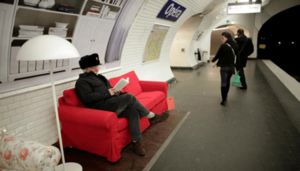
In March 2010, IKEA displayed furniture collections in four major Métro stations in Paris, letting people see their products while waiting for trains.
In 2017, IKEA launched the "IKEA Human Catalogue" campaign. A memory champion named Yanjaa Wintersoul memorized all 328 pages of the IKEA catalogue! She showed off her amazing memory at events and on TV shows.
In 2020, IKEA had a "Buy Back Friday" campaign. Instead of just selling new items for Black Friday, they encouraged customers to sell their old IKEA furniture back to the company, giving it a new life.
In June 2021, IKEA stopped advertising on GB News because they felt the channel's content didn't match their values of being inclusive.
In August 2023, IKEA launched short 6-second ads called “Ads That Skip You.” These ads showed how organizing with IKEA products helps you find things quickly, so you have time to "skip ad" on videos. These ads were very successful. In September 2024, IKEA started using everyday windows as outdoor advertising spaces.
See also
 In Spanish: IKEA para niños
In Spanish: IKEA para niños


